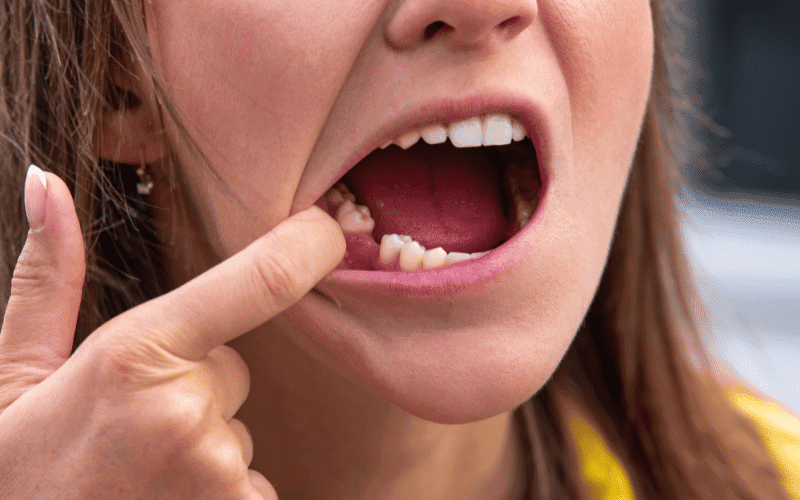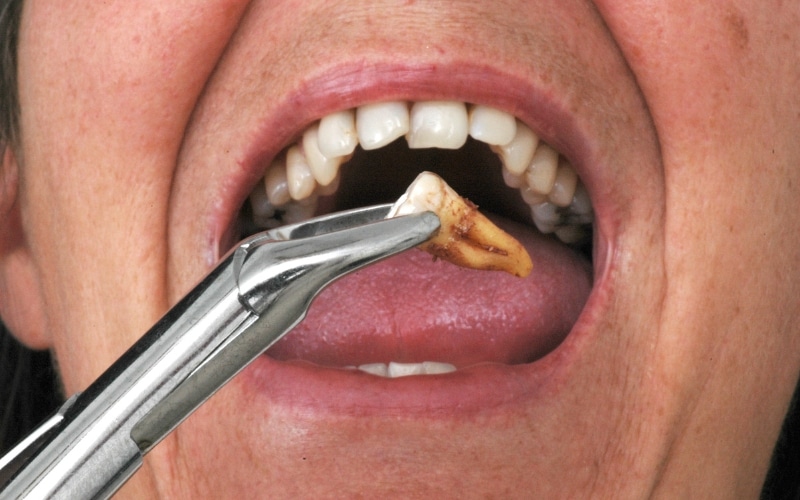
A dental procedure known as tooth extraction involves the removal of a tooth from its socket in the jawbone. This treatment is typically employed in cases of severe decay, infection, crowding, or trauma. Before the extraction process, the dentist or oral surgeon administers local anesthesia to numb the area. Specialized instruments are then used to gently loosen and remove the tooth. Following the extraction, patients may experience mild discomfort and are advised to adhere to post-operative care instructions, which include rest and avoiding specific foods. It is essential to note the existence of “Restrictions After Tooth Extraction” to ensure proper healing and recovery. Despite the routine nature of tooth extraction, ongoing advancements in dentistry aim to minimize pain and facilitate a speedy recovery for individuals undergoing this procedure.
Common Restrictions After Tooth Extraction
1. Dietary Restrictions: Avoid hot or spicy foods and hard and crunchy items that may irritate the extraction site. Stick to soft, cool, and easy-to-chew foods like yogurt, smoothies, and soups during the initial healing period.
2. Avoiding Strenuous Activities: Refrain from vigorous physical activities for a few days to prevent increased blood flow to the extraction site, which could lead to bleeding or discomfort. This includes intense exercise, heavy lifting, and strenuous workouts.
3. No Smoking or Tobacco Use: Smoking can interfere with the healing process and increase the risk of complications. It is advisable to refrain from smoking or using any tobacco products for a specified period after tooth extraction.
4. Careful Oral Hygiene Practices: Gentle oral hygiene is crucial, but avoid brushing the extraction site directly for the first few days. Use a soft-bristled toothbrush and be cautious while rinsing to prevent dislodging the blood clot that forms in the socket, promoting proper healing.
5. Follow Medication Instructions: Take prescribed medications, such as pain relievers or antibiotics, as the dentist directs. This helps manage pain, prevent infection, and support healing. Report any unusual side effects or concerns promptly to the dental professional.
Physical Restrictions After Tooth Extraction
1. Lifting Restrictions: Avoid heavy lifting or carrying objects that may strain the body, especially if the extraction site is in an area where exertion could impact the healing process.
2. Bending and Twisting: Minimize activities that involve bending at the waist or twisting the body, as these motions can increase blood flow and pressure, potentially affecting the extraction site’s healing.
3. Strenuous Exercise: Refrain from engaging in intense or strenuous physical activities, including activities that involve rapid movements or jarring impacts, as this may disrupt the healing process and lead to complications.
4. Limiting Physical Stress: Reduce physical stress on the body by avoiding activities that may cause strain, tension, or physical discomfort. This helps in promoting a smoother recovery after the tooth extraction.
5. Rest and Relaxation: Allow adequate time for rest, allowing the body to heal. Good sleep and a generally calm physical state contribute positively to the recovery process after a tooth extraction.
Dietary Restrictions After Tooth Extraction
1. Avoid Hard and Crunchy Foods: Avoid hard and crunchy foods that can exert pressure on the extraction site, potentially causing discomfort or dislodging the blood clot essential for healing.
2. Limit Hot and Spicy Foods: Hot foods may irritate the sensitive area around the extraction site. Opt for cooler or lukewarm foods during the initial days to prevent unnecessary discomfort.
3. Refrain from Chewy or Sticky Foods: Chewy or sticky foods like gum or candies can adhere to the extraction site and disrupt the healing process. It’s advisable to avoid such items until the area has sufficiently healed.
4. No Straws: Refrain from using straws when drinking liquids, as the sucking motion can create negative pressure in the mouth, potentially dislodging the blood clot and delaying the healing process.
5. Alcohol and Tobacco Restrictions: Avoid alcohol and tobacco products, as they can impede the healing process and increase the risk of complications. These substances can also irritate the extraction site and contribute to delayed recovery.
Activity Restrictions
1. Avoid Strenuous Exercise: Refrain from engaging in vigorous physical activities or intense exercise that may increase blood flow and elevate heart rate, potentially leading to bleeding or discomfort at the extraction site.
2. Minimize Bending and Lifting: Limit activities that involve bending at the waist or heavy lifting, as these actions can strain the body and impact the healing process, mainly if the extraction site is in the lower jaw.
3. No Contact Sports: Avoid participating in contact sports or activities that pose a face or mouth injury risk. Protect the extraction site from any accidental trauma that could compromise the healing.
4. Rest and Relaxation: Prioritize rest and allow your body to recover by avoiding excessive physical exertion. Adequate rest contributes to a smoother healing process after tooth extraction.
5. Be Mindful of Head Position: Avoid activities that require tilting the head back, as this may increase blood flow to the head and potentially disrupt the healing process. Maintain a neutral head position to minimize stress on the extraction site.
Tips for a Smooth Recovery
1. Follow Post-Operative Instructions: Adhere to the guidelines provided by your dentist or oral surgeon. This includes taking prescribed medications, following recommended oral care practices, and avoiding activities that could hinder healing.
2. Maintain Good Oral Hygiene: Clean your mouth to prevent infection, but be cautious around the extraction site. Use a soft-bristled toothbrush and follow your dentist’s additional oral hygiene recommendations.
3. Apply Ice Packs: Use ice packs on the outside of your face for the first 24 hours to help minimize swelling and alleviate discomfort. Be sure to follow the recommended schedule for application to avoid prolonged exposure.
4. Eat Soft and Nutrient-Rich Foods: Consume a diet rich in soft, nutrient-dense foods to support healing. This can include items like yogurt, mashed potatoes, and smoothies. Don’t eat anything that might irritate the extraction site.
5. Attend Follow-Up Appointments: Keep follow-up appointments with your dentist to monitor healing progress and address concerns. This allows for timely intervention if complications arise and ensures a smooth recovery.
In conclusion, for a seamless recovery from tooth extraction in San Juan Capistrano, trust the expertise of Ortega Cottage Dentistry. Following post-operative guidelines, maintaining proper oral hygiene, and promptly addressing concerns are critical to a smooth healing process.
Ortega Cottage Dentistry ensures personalized care, addressing excessive bleeding, infection, or persistent discomfort. For a pain-free and optimal recovery experience, choose the trusted hands of Ortega Cottage Dentistry.
Your journey to a healthier smile begins here. Make an appointment right now to receive professional dental care! Remember, at Ortega Cottage Dentistry, your smile is our priority.



